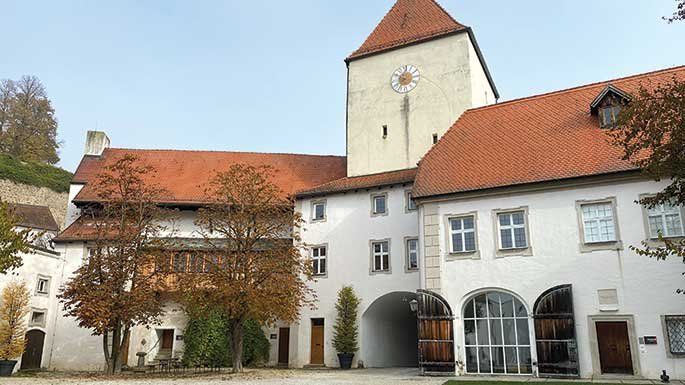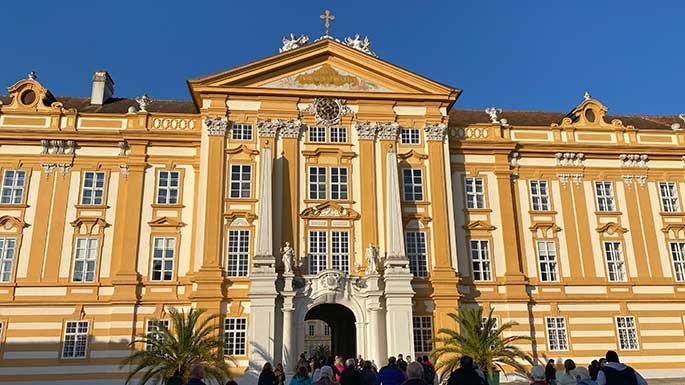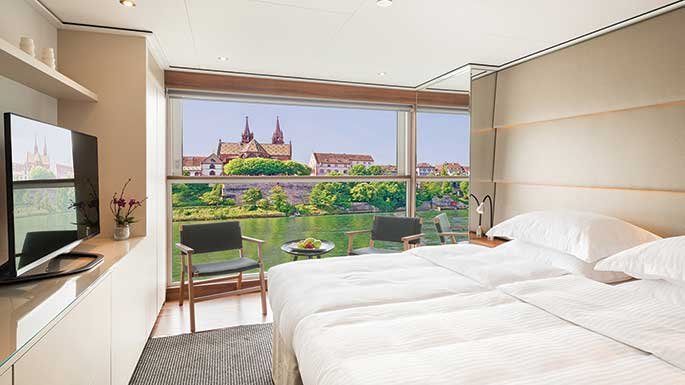Adventures on the Blue Danube
/After our steep climb, the views of the Danube River from the castle ruins in Dürnstein made all the effort worthwhile. (PHOTO BY PEGGY SIJSWERDA)
Imagine being lulled to sleep by the soothing sound of rippling water. Imagine waking up at sunrise, peering out your window, and seeing a centuries-old city emerge slowly, eerily through the early morning fog. Imagine walking down a gangplank, and within minutes, you’re in the middle of an ancient city, no long bus ride or tender journey required.
Some are cities you’ve heard of and longed to visit: Vienna, Bratislava, and Budapest. Others’ names are new to your ears, but their charms quickly cast an intoxicating spell, luring you toward their cobblestoned streets, tall turrets, and imposing castles and monasteries, where the secrets of history are hidden amid the ancient stones.
Welcome to Emerald Cruises’ Danube Delights, a luxurious foray along one of the world’s most storied rivers, where you will follow in the wake of ancient Greeks and Romans who settled along its banks, as well as emperors like Charlemagne, Franz Joseph, and Napoleon, whose power extended far beyond the banks of the Danube to distant lands.
This fall Peter and I explored this historic river on an eight-day cruise aboard Emerald Destiny at a time when people are slowly venturing back toward traveling abroad. Our ship has a capacity of 180 passengers, yet there were only 76 of us on board, not counting the crew of 50+ smiling faces who took care of us all week. Their personal attention and top-notch service made us feel as if we were all VIPs!
Along the way, we explored beautiful towns and cities as we sailed on the Danube through Germany, Austria, Slovakia, and Hungary. Come along with Peter and me on our once-in-a-lifetime adventure with one of the world’s leading cruise lines. All aboard!
Regensburg: Lively University City
Don’t Miss the Stone Bridge & St. Peter’s Cathedral
Hungry for a bratwurst? Stop in this cozy cafe in Regensburg by the Stone Bridge, where you can munch on the local sausage—served with sweet Bavarian mustard, of course. (PHOTO BY P. SIJSWERDA)
Just days before the cruise was to embark, Peter and I received word that the Danube’s water level was too low in Nuremburg, where our cruise was to begin, and that the new embarkation port would be Regensburg, about 70 miles downriver. It was no problem for us as Peter and I planned to drive from Northern Germany, where we were staying with Peter’s sister, in a car we recently purchased to use while traveling in Europe.
Our only concern was where we would park while the cruise took place. Thanks to Google Maps, I found a free (!) parking area right beside the Danube. When we arrived and saw the lot was full of late-model cars, we knew it would be safe to leave the car there until we returned by train about a week later. So far, so good.
Imagine our surprise when after parking our car, we looked across the river and saw the Emerald Destiny, a short walk away. What luck! The crew greeted us warmly, and after checking into our beautiful panorama balcony suite, we strolled into Regensburg, a lively university town filled with shops, cafes, restaurants, and gathering places.
Turns out it’s brimming with history, too, as we discovered the next day on a tour with Hubert, our friendly guide, who was full of stories, facts, and figures about his beloved city. Dating back to the Roman times, Regensburg still shows evidence of its first settlers: extant sections of a Roman wall and an impressive city gate dating back to the 2nd century.
Unlike many German cities, Regensburg did not suffer a lot of destruction during sieges and wars throughout history. So a variety of architectural styles can be seen, including a number of patriarchal towers rising up like sentries throughout the old city. Back in the day, building higher and higher towers was how wealthy patricians displayed their wealth and importance. Add in a beautiful stone bridge constructed in the 12th century—one of Europe’s earliest surviving bridges, and St. Peter’s Cathedral—a Gothic masterpiece with two spires that seem to reach to heaven, and soon, like Hubert, you’ll be singing the city’s praises.
Anyone who’s ever been on a cruise will agree that meals are a highlight, and Emerald Cruises didn’t disappoint. Every day delicious options awaited at breakfast, lunch, and dinner, served by polite, attentive servers and managed brilliantly by Sasha, our smiling maître D. My favorite was Milos, who always called me “Madam” and made sure my wine glass stayed full. Often the chef, who hailed from the UK, would include local specialties on the menu, such as crispy fried schnitzel in Germany and hearty goulash soup, redolent of smoky paprika, in Hungary.
The breakfast and lunch buffets were stellar. In the morning, fresh, crusty bread and pastries awaited along with a variety of cheese, meat, and fish. You could also order omelets at the egg station or opt for muesli and yogurt. The lunch buffet always had lovely, fresh salad greens, as well as a tempting pasta station or you could order from the menu. Three-course dinners provided the perfect finale to our busy days with multiple options, including the chef’s recommendation for the day.
Passau: Where Three Rivers Meet
Don’t Miss St. Stephen’s & the Hike to Veste Oberhaus
As we walked around Veste Oberhaus, or the bishop’s fortress, in Passau after the fog lifted, we discovered the beautiful Oberhausmuseum. (PHOTO BY PEGGY SIJSWERDA)
Speaking of busy days, be prepared for an active itinerary on the cruise. Besides city tours, there are EmeraldACTIVE activities for passengers—like me—who want to work off all those calories we were consuming!
In our second port, Passau, straddling the German-Austrian border, we met Anton one foggy morning for an informative tour of the city that Napoleon described as Germany’s most beautiful. Its centerpiece is St. Stephen’s Cathedral, an imposing white building originally designed in the Gothic style—think Notre Dame in Paris.
Due to a fire, it was re-built in the Baroque style, defined by its vividly painted frescoed ceilings and brilliant gilded statuary. The cathedral is home to the one of the world’s largest organs with 17,974 pipes and 233 registers. While we were there, it was being cleaned, so our tour was enhanced by the rich, sometimes eerie sounds of the organ playing random notes.
After the tour, Peter decided to stay in Passau and attend the organ concert at St. Stephen’s at noon, a bargain at five euros (about $6). I, on the other hand, joined an intrepid group of fellow passengers led by Drazen, the ship’s activity manager, for an EmeraldACTIVE hike to Veste Oberhaus, or the bishop’s fortress, high up on a cliff overlooking the city. Up 200 steps we climbed, followed by stretches of smooth paths gently ascending to the summit. We stopped to rest a couple times, so the hike wasn’t too bad. The view from the top? Simply amazing.
Today the fortress houses a museum, a youth hostel, a café, and an outdoor theatre, but we were there for the view. It was about noon when we reached the top, and the fog still obscured our view of Passau below. Slowly but surely, like a ghost emerging from the mist, the shapes of the city’s buildings began to appear. Before long, we could see all of Passau’s spires and steeples, including the magnificent St. Stephen’s, as well as the three rivers that flank the city’s shores. Peter told me later he enjoyed the concert, but I’m glad I opted for the beautiful hike.
Melk: A Royal Abbey Visited by the Hapsburgs
The Dazzling Abbey Church Also Houses Two Catacomb Saints
Melk Abbey has an impressive history, but the opulent Abbey Church is a highlight. Don’t miss the views of the city and the Blue Danube from its lofty perch. (PHOTO BY PEGGY SIJSWERDA)
It wouldn’t be the last. Our next stop was Melk, a charming Austrian town, and Melk Abbey, a huge, imposing monastery, home to 27 Benedictine monks and an active secondary school for 900 boys and girls. We walked through a park, crossed a bridge, and then climbed a few flights of stairs to the abbey. The hike wasn’t as strenuous as the previous day’s, yet the views that awaited were equally as impressive.
First we entered an inner courtyard, one of seven, where we met our guide, Ludmilla, for a tour of the abbey. I was surprised at how opulent the buildings were considering this is a home for monks. In fact, after the monastery was built, the Benedictine order of monks began to gravitate to a more frugal, less ostentatious lifestyle. But Melk Abbey stands as a beautiful example of an era in history when frugality was definitely not in vogue.
Members of the Royal Hapsburg family often stayed at Melk Abbey, which became a favorite of Archduchess Maria Theresa, who ruled the Austro-Hungarian empire from 1745 until her death in 1780, the only woman to hold the position. The mother of 16 children, including the ill-fated Marie Antoinette, the archduchess introduced reforms that improved the lives of her subjects, including compulsory education.
As Ludmilla shared tidbits of the monastery’s history, we wandered through a few of the 497 rooms, including a blue meditation room, where a statue of St. Benedict is found. He wrote the rule book followed by all Benedictine monks to this day, whose precepts, Ludmilla explained, could be summed up in three words, “Pray. Work. Read.” Good advice for all of us, I believe.
As you would imagine the Abbey Church is richly ornamented with gilded statues, colorful frescoes, and a high altar that shines in gold and silver. Tucked into nooks in the church’s side walls, an eerie sight awaits the curious: two glass sarcophagi, each holding a skeleton, the remains of two “catacomb saints.” I couldn’t believe my eyes—how macabre—especially since one of them was holding a green feather and almost looked like he was smiling.
Dürnstein: Majestic Mountains & Amazing Views
Take the Hike to Kuenringerburg Castle
The peaceful pool area in the aft of the ship also doubles as a movie theater and a yoga room. (Photo courtesy Emerald Cruises)
Cruise guests were invited to join a bike tour from Melk to our next stop, Dürnstein, about 20 miles downriver along a paved path that paralleled the river. I was tempted, but decided to stay on the Emerald Destiny since we would be cruising through some of the prettiest scenery in the Wachau region of Austria. Just as with big-ship cruises, the captain usually moves the ship from port to port while we sleep, so being able to watch the scenery go by is a rarity, especially in autumn when darkness falls around 5 p.m.
Except for the valiant few who chose to cycle along the Danube, passengers gathered in the lounge and on the open-air deck to ooh and ahh as we cruised by beautiful mountains, colorful towns, and fairytale castles perched halfway up to the sky. Our genial cruise director, Alex, a native Austrian, provided a running commentary, and before long, we landed in the little village of Dürnstein, where yet another hike awaited anyone who was game.
Peter wasn’t, but I was, and this one was a doozy, a steep ascent up to the ruins of a castle called Kuenringerburg, where legend says Richard the Lionhearted of England was imprisoned while his captors awaited ransom from Richard’s homeland. The weather was gorgeous, so dozens of other hikers, including families with toddlers (!), marched up the steep, rocky path to the castle ruins. This was the most challenging hike, but we made it, albeit breathlessly, to the top, where spectacular views awaited.
Beside us vineyards cascaded down mountain slopes, and below the colorful town of Dürnstein looked as if it came straight from a Grimm’s fairytale. Snaking lazily from west to east, the Danube flowed like a silver ribbon through the pastoral scenery. Across the river, majestic mountains seemed to march toward the horizon. The air smelled so fresh, and the autumn sun warmed my skin. Our guide, who was born and raised in the town, told us in winter, when all the tourists are gone, it’s as if Dürnstein goes to sleep.
Later that afternoon back on the ship, I finally found a few minutes to write in my journal. Peter was off somewhere, so I grabbed a glass of wine and headed down to the pool area in the aft of the ship. Relaxing in a comfy chair all alone, I listened to the pool slosh gently to and fro as Tony Bennett crooned on the sound system and the Emerald Destiny got underway to our next destination. In between writing in my journal, I paused to watch the sky change color from blue to orange to pink to silvery gray, like a painting in motion, as the ship cruised down the Blue Danube toward our next port—Vienna!
Plan Your Own River Cruise with Emerald Cruises
All the Resources You Need for a Fabulous Getaway
We loved waking up to see what new views awaited each morning from the comfort of our Panorama Balcony Suite. (Photo courtesy Emerald Cruises)
Check out Emerald Cruise Discounts
Get the latest offers and deals for river cruises at www.emeraldcruises.com.
The Danube River Ports We Visited
Regensburg is a lively college town known for St. Peter’s Cathedral and the Stone Bridge. Here’s where you can find out more about the city’s history as well as tourist information including hotels and restaurants. Go to tourismus.regensburg.de/en.
Passau is known as the city of three rivers, as well as home to St. Stephen’s Cathedral with one of the largest organs in the world. Wander Passau’s cobblestoned streets and marvel at its unique architecture and heritage. Get more travel information, including how to get around, tours and special events at tourism.passau.de.
Melk, Austria, is famous for the majestic Melk Abbey, which was visited by royal members of the Habsburg dynasty. Today it’s a monastery for Benedictine monks as well as a secondary school for boys and girls. Find out more about tours of the abbey, history of the town, and more at www.stadt-melk.at/en/Tourism_2.
Dürnstein, Austria, is a lovely village where vineyards grow next to the Danube and beautiful views are the reward for those intrepid hikers who climb up to the ruins of the Kuenringerburg Castle. Afterwards sip on a tasty local wine at a cozy wine tavern in the picturesque village. Find out more at www.duernstein.at/en/.



















